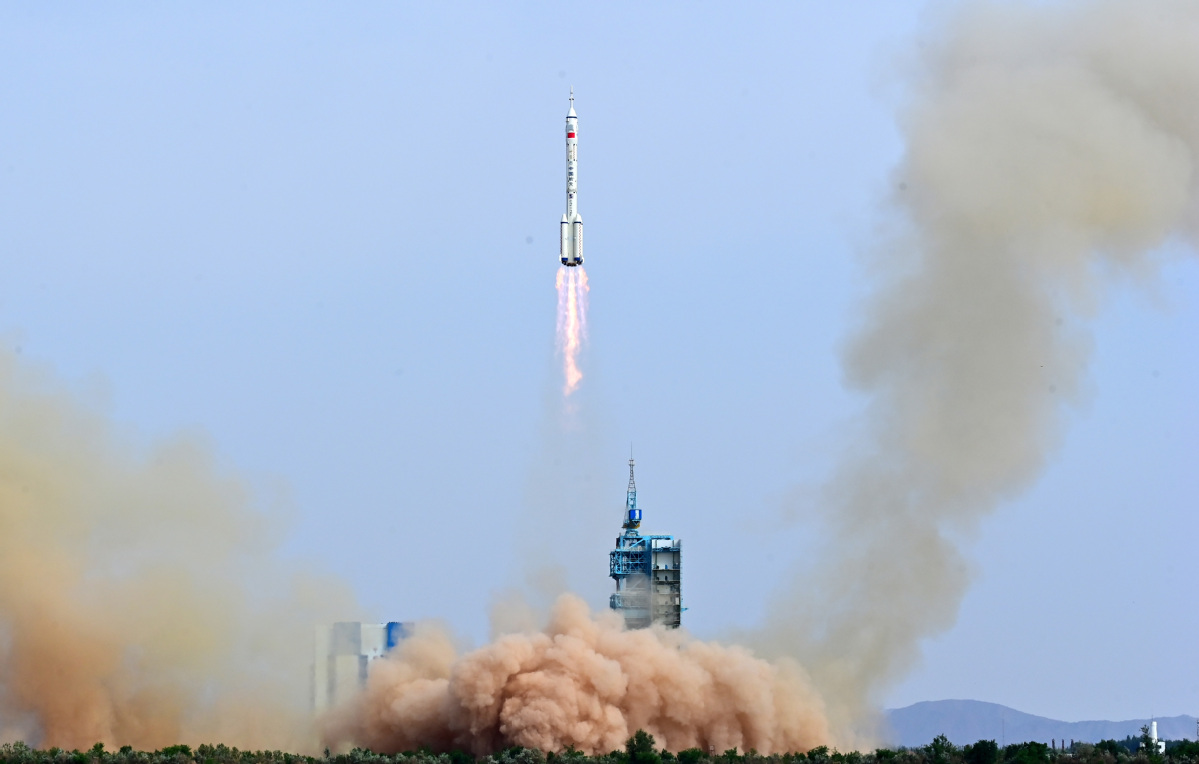
China on Tuesday launched the Shenzhou XVI manned spaceship, sending three astronauts to its space station combination for a five-month mission.
Sitting inside the Shenzhou XVI spacecraft, Gui Haichao and his commander Major General Jing Haipeng and fellow astronaut Colonel Zhu Yangzhu were launched by a 20-story-tall Long March 2F carrier rocket that left the ground at 9:31 am at the Jiuquan Satellite Launch Center in Gobi Desert. After a short flight, the spaceship was placed into a low-Earth orbit about 400 kilometers above the planet. Within hours of the launch, the manned craft is due to approach and dock with the Tianhe core module (核心舱) of the Tiangong space station. The crew will then move into the Tiangong to meet the astronauts from the Shenzhou XV mission — commander Major General Fei Junlong, Senior Colonel Deng Qingming and Senior Colonel Zhang Lu — who arrived on Nov. 30, 2022.
The Shenzhou XVI crew members will stay inside the Tiangong space station for around five months and are scheduled to return in November, 2023. They will carry out several spacewalks during the mission to mount equipment outside the station and also conduct maintenance work.
The journey is the first flight of China’s third generation of astronauts, and the first time a Chinese civilian has traveled to space. Jing and Zhu are members of the People’s Liberation Army’s Astronaut Division, while Gui is a doctoral supervisor at the Department of Spacecraft and Launch Vehicle Technology of Beihang University’s School of Astronautics in Beijing. Until the latest mission, all Chinese astronauts who have taken part in spaceflights have been military personnel. The first two generations of astronauts were selected from experienced Air Force aviators. The third generation of astronauts, which was grouped around October 2020, includes civilians. Zhu and Gui are the first members of the third-generation astronauts to enter the space.
本时文内容由奇速英语国际教育研究院原创编写,未经书面授权,禁止复制和任何商业用途,版权所有,侵权必究!(作者投稿及时文阅读定制请联系微信:18980471698)1.Which question can’t the second paragraph answer?
A Who commands the Shenzhou XVI mission?
B How long will the Shenzhou XVI crew spend in space?
C Who crew the Shenzhou XVI mission?
D Where did the Shenzhou XVI spacecraft launch?
解析:选B。B细节理解题。根据第二段第一句的“Sitting inside the Shenzhou XVI spacecraft, Gui Haichao and his commander Major General Jing Haipeng and fellow astronaut Colonel Zhu Yangzhu were launched by a 20-story-tall Long March 2F carrier rocket that left the ground at 9:31 am at the Jiuquan Satellite Launch Center in Gobi Desert.”可知,搭载神舟十六号载人飞船的长征二号F运载火箭,在酒泉卫星发射中心点火升空,成功将航天员景海鹏、朱杨柱、桂海潮顺利送入太空,景海鹏担任神舟十六号飞行乘组指令长,该段并没有提到他们会在太空待多久。故选B。
2.What is described in the third paragraph?
A Preparations for the launch of the Shenzhou XVI spacecraft.
B Introductions to China’s next manned space mission.
C The send-off ceremony of the Shenzhou XVI spacecraft.
D Tasks of Shenzhou XVI manned space mission.
解析:选D。D 段落大意题。该段主要讲了神舟十六号载人飞船的飞行任务。故选D。
3.How is the Shenzhou XVI manned space mission different from other missions?
A The civilian astronaut joined it for the first time.
B Astronauts gave online lectures in space for the first time.
C The civilian astronaut commands the mission for the first time.
D The crew are all made up of the second-generation astronauts.
解析:选A。A 细节理解题。根据第四段第一句的“The journey is the first flight of China’s third generation of astronauts, and the first time a Chinese civilian has traveled to space.”和第三句的“Until the latest mission, all Chinese astronauts who have taken part in spaceflights have been military personnel.”可知,中国将三名宇航员送入太空,其中包括第一位平民宇航员。故选A。
4.What does the text focus on?
A Shenzhou XVI crew looks forward to challenge.
B The successful launch of Shenzhou-16 manned spaceship.
C Gui Haichao to be 1st Chinese civilian in space.
D The announcement of Shenzhou-16 manned spaceship.
解析:选B。B 主旨大意题。本文主要介绍了神舟十六号飞船的成功发射。故选B。